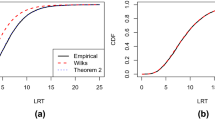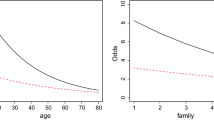Abstract
A unifying framework for generalized multilevel structural equation modeling is introduced. The models in the framework, called generalized linear latent and mixed models (GLLAMM), combine features of generalized linear mixed models (GLMM) and structural equation models (SEM) and consist of a response model and a structural model for the latent variables. The response model generalizes GLMMs to incorporate factor structures in addition to random intercepts and coefficients. As in GLMMs, the data can have an arbitrary number of levels and can be highly unbalanced with different numbers of lower-level units in the higher-level units and missing data. A wide range of response processes can be modeled including ordered and unordered categorical responses, counts, and responses of mixed types. The structural model is similar to the structural part of a SEM except that it may include latent and observed variables varying at different levels. For example, unit-level latent variables (factors or random coefficients) can be regressed on cluster-level latent variables. Special cases of this framework are explored and data from the British Social Attitudes Survey are used for illustration. Maximum likelihood estimation and empirical Bayes latent score prediction within the GLLAMM framework can be performed using adaptive quadrature in gllamm, a freely available program running in Stata.
Similar content being viewed by others
References
Ansari, A., & Jedidi, K. (2000). Bayesian factor analysis for multilevel binary observations.Psychometrika, 65, 475–496.
Arminger, G., & Sobel, M. (1990). Pseudo maximum likelihood estimation of mean- and covariance structures with missing data.Journal of the American Statistical Association, 85, 195–203.
Asparouhov, T., & Muthén, B.O. (2004). Full-information maximum-likelihood estimation of general two-level latent variable models. Draft.
Bollen, K.A. (1989).Structural Equations with Latent Variables. New York: Wiley.
Böckenholt, U. (2001). Hierarchical modeling of paired comparison data.Psychological Methods, 6, 49–66.
Carroll, R.J., Ruppert, D., & Stefanski, L.A. (1995).Measurement Error in Nonlinear Models. London: Chapman & Hall.
Chou, C.-P., Bentler, P.M., & Pentz, M.A. (2000). A two-stage approach to multilevel structural equation models: application to longitudinal data. In T.D. Little, K.U. Schnabel, & J. Baumert (Eds.),Modeling Longitudinal and Multilevel Data (pp. 33–49). Mahwah, NJ: Erlbaum.
Clayton, D. (1988). The analysis of event history data: a review of progress and outstanding problems.Statistics in Medicine, 7, 819–841.
Clogg, C. C. (1995). Latent class models. In G. Arminger, C.C. Clogg, & M.E. Sobel (Eds.),Handbook of Statistical Modeling for the Social and Behavioral Sciences (pp. 311–359). New York: Plenum Press.
Dohoo, I.R., Tillard, E., Stryhn, H., & Faye, B. (2001). The use of multilevel models to evaluate sources of variation in reproductive performance in dairy cattle.Preventive Veterinary Medicine, 50, 127–144.
Fox, J.P. (2001).Multilevel IRT: A Bayesian Perspective on Estimating Parameters and Testing Statistical Hypotheses. Ph.D. thesis, University of Twente, Enschede.
Fox, J.P., & Glas, C. A.W. (2001). Bayesian estimation of a multilevel IRT model using Gibbs sampling.Psychometrika, 66, 271–288.
Fox, J.P., & Glas, C. A.W. (2003). Bayesian modeling of measurement error in predictor variables using item response theory.Psychometrika, 68, 169–191.
Goldstein, H. (1986). Multilevel mixed linear model analysis using iterative generalised least squares.Biometrika, 73, 43–56.
Goldstein, H. (1995).Multilevel Statistical Models. London: Arnold.
Goldstein, H., & Browne, W. (2002). Multilevel factor analysis modeling using Markov Chain Monte Carlo (MCMC) estimation. In G.A. Marcoulides & I. Moustaki (Eds.),Latent Variable and Latent Structure Models. Mahwah, NJ: Erlbaum.
Goldstein, H., & McDonald, R.P. (1988). A general model for the analysis of multilevel data.Psychometrika, 53, 455–467.
Hagenaars, J.A. (1988). Latent structure models with direct effects between indicators: local dependence models.Sociological Methods & Research, 16, 379–405.
Harper, D. (1972). Local dependence latent structure models.Psychometrika, 37, 53–59.
Heckman, J.J. (1979). Sample selection bias as a specification error.Econometrica, 47, 153–161.
Heckman, J.J., & Singer, B. (1984). A method of minimizing the impact of distributional assumptions in econometric models for duration data.Econometrica, 52, 271–320.
Hox, J. (2002).Multilevel Analysis: Techniques and Applications. Mahwah, NJ: Erlbaum.
Jöreskog, K.G. (1971). Simultaneous factor analysis in several populations.Psychometrika, 36, 409–426.
Jöreskog, K.G. (1973). A general method for estimating a linear structural equation system. In A.S. Goldberger & O.D. Duncan (Eds.),Structural Equation Models in the Social Sciences (pp. 85–112). New York: Seminar.
Jöreskog, K.G. & Goldberger, A.S. (1975). Estimation of a model with multiple indicators and multiple causes of a single latent variable.Journal of the American Statistical Association, 70, 631–639.
Jöreskog, K.G., & Sörbom, D. (1989).LISREL 7: A Guide to the Program and Applications. Chicago, IL: SPSS Publications.
Knott, M., Albanese, M.T., & Galbraith, J.I. (1990). Scoring attitudes to abortion.The Statistician, 40, 217–223.
Laird, N.M. (1978). Nonparametric maximum likelihood estimation of a mixing distribution.Journal of the American Statistical Association, 73, 805–811.
Lee, S.-Y., & Shi, J.-Q. (2001). Maximum likelihood estimation of two-level latent variable models with mixed continuous and polytomous data.Biometrics, 57, 787–794.
Lee, S.-Y., & Tsang, S.-Y. (1999). Constrained maximum likelihood estimation of two-level covariance structure models via EM type algorithms.Psychometrika, 64, 435–450.
Lesaffre, E., & Spiessens, B. (2001). On the effect of the number of quadrature points in a logistic random-effects model: an example.Applied Statistics, 50, 325–335.
Liang, J., & Bentler, P. M. (2003). An EM algorithm for fitting two-level structural equation models.Psychometrika, in press.
Linda, N.Y., Lee, S.-Y., & Poon, W.-Y. (1993). Covariance structure analysis with three level data.Computational Statistics & Data Analysis, 15, 159–178.
Longford, N.T. (1993).Random Coefficient Models. Oxford: Oxford University Press.
Longford, N.T., & Muthén, B.O. (1992). Factor analysis for clustered observations.Psychometrika, 57, 581–597.
McArdle, J.J. (1986). Latent variable growth within behavior genetic models.Behavior Genetics, 16, 163–200.
McDonald, R.P., & Goldstein, H. (1989). Balanced and unbalanced designs for linear structural relations in two-level data.British Journal of Mathematical and Statistical Psychology, 42, 215–232.
Meredith, W. & Tisak, J. (1990). Latent curve analysis.Psychometrika, 55, 107–122.
Muthén, B.O. (1984). A general structural equation model with dichotomous, ordered categorical and continuous latent indicators.Psychometrika, 49, 115–132.
Muthén, B.O. (1985). A method for studying the homogeneity of test items with respect to other relevant variables.Journal of Educational Statistics, 10, 121–132.
Muthén, B.O. (1989). Latent variable modeling in heterogeneous populations.Psychometrika, 54, 557–585.
Muthén, B.O. (1994). Multilevel covariance structure analysis.Sociological Methods & Research, 22, 376–398.
Muthén, B.O. (1997). Latent variable modeling of longitudinal and multilevel data. In A.E. Raftery (Ed.),Sociological Methodology 1997 (pp. 453–480). Cambridge, MA: Blackwell.
Muthén, B.O. (2002). Beyond SEM: General latent variable modeling.Behaviormetrika, 29, 81–117.
Muthén, L.K., & Muthén, B.O. (1998).Mplus User's Guide. Los Angeles, CA: Muthén & Muthén.
Neale, M.C., & Cardon, L.R. (1992).Methodology for Genetic Studies of Twins and Families. London: Kluwer.
Pickles, A., Pickering, K., Simonoff, E., Meyer, J., Silberg, J., & Maes, H. (1998). Genetic clocks and soft events: A twin model for pubertal development and other recalled sequences of developmental milestones.Behavior Genetics, 28, 243–253.
Plummer, M., & Clayton, D. (1993). Measurement error in dietary assessment: an investigation using covariance structure models. Part II.Statistics in Medicine, 12, 937–948.
Poon, W.-Y., & Lee, S.-Y. (1992). Maximum likelihood and generalized least squares analyses of two-level structural equation models.Statistics and Probability Letters, 14, 25–30.
Rabe-Hesketh, S., & Pickles, A. (1999). Generalised linear latent and mixed models. In H. Friedl, A. Berghold & G. Kauermann (Eds.),Proceedings of the 14th International Workshop on Statistical Modeling (pp. 332–339). Graz, Austria.
Rabe-Hesketh, S., Pickles, A., & Skrondal, A. (2001a). GLLAMM: A general class of multilevel models and a Stata program.Multilevel Modelling Newsletter, 13, 17–23.
Rabe-Hesketh, S., Pickles, A., & Skrondal, A. (2001b).GLLAMM Manual. Tech. rept. 2001/01. Department of Biostatistics and Computing, Institute of Psychiatry, King's College, University of London. Downloadable from http://www.gllamm.org.
Rabe-Hesketh, S., Pickles, A., & Skrondal, A. (2003). Correcting for covariate measurement error in logistic regression using nonparametric maximum likelihood estimation.Statistical Modelling, 3, 215–232.
Rabe-Hesketh, S., Pickles, A., & Taylor, C. (2000). sg129: Generalized linear latent and mixed models.Stata Technical Bulletin, 53, 47–57.
Rabe-Hesketh, S., & Skrondal, A. (2001). Parameterization of multivariate random effects models for categorical data.Biometrics, 57, 1256–1264.
Rabe-Hesketh, S., Skrondal, A., & Pickles, A. (2002). Reliable estimation of generalized linear mixed models using adaptive quadrature.The Stata Journal, 2, 1–21.
Rabe-Hesketh, S., Skrondal, A., & Pickles, A. (2003). Maximum likelihood estimation of generalized linear models with covariate measurement error.The Stata Journal, 3, 386–411.
Rabe-Hesketh, S., Skrondal, A., & Pickles, A. (2004). Maximum likelihood estimation of limited and discrete dependent variable models with nested random effects.Journal of Econometrics, in press.
Rabe-Hesketh, S., Toulopoulou, T., & Murray, R. (2001). Multilevel modeling of cognitive function in schizophrenic patients and their first degree relatives.Multivariate Behavioral Research, 36, 279–298.
Rabe-Hesketh, S., Yang, S., & Pickles, A. (2001). Multilevel models for censored and latent responses.Statistical Methods in Medical Research, 10, 409–427.
Rasbash, J., Browne, W., Goldstein, H., Yang, M., Plewis, I., Healy, M., Woodhouse, G., Draper, D., Langford, I., & Lewis, T. (2000).A User's Guide to MLwiN (second edition). London: Institute of Education, University of London.
Raudenbush, S.W. (1995). Maximum likelihood estimation for unbalanced multilevel covariance structure models via the EM algorithm.British Journal of Mathematical and Statistical Psychology, 48, 359–370.
Raudenbush, S.W., Bryk, A.S., Cheong, Y.F., & Congdon, R. (2000).HLM 5: Hierarchical Linear and Nonlinear Modeling. Lincolnwood, IL: Scientific Software International.
Raudenbush, S.W., & Bryk, A.S. (2002).Hierarchical Linear Models: Applications and Data Analysis Methods. Thousand Oaks, CA: Sage.
Raudenbush, S.W., & Sampson, R. (1999a). Assessing direct and indirect effects in multilevel designs with latent variables.Sociological Methods & Research, 28, 123–153.
Raudenbush, S.W., & Sampson, R. (1999b). Ecometrics: toward a science of assessing ecological settings, with application to the systematic social observation of neighborhoods. In P.V. Marsden (Ed.),Sociological Methodology 1999, vol. 29 (pp. 1–41). Oxford: Blackwell.
Rijmen, F., Tuerlinckx, F., De Boeck, P., and Kuppens, P. (2003). A nonlinear mixed model framework for IRT models.Psychological Methods, 8, 185–205.
Rindskopf, D. (1984). Using phantom and imaginary latent variables to parameterize constraints in linear structural models.Psychometrika, 49, 37–47.
Skrondal, A., & Laake, P. (2001). Regression among factor scores.Psychometrika, 66, 563–576.
Skrondal, A., & Rabe-Hesketh, S. (2003a). Multilevel logistic regression for polytomous data and rankings.Psychometrika, 68, 267–287.
Skrondal, A., & Rabe-Hesketh, S. (2003b). Some applications of generalized linear latent and mixed models in epidemiology: Repeated measures, measurement error and multilevel modeling.Norwegian Journal of Epidemiology, 13, 265–278.
Skrondal, A., & Rabe-Hesketh, S. (2004a).Generalized latent variable modeling: Multilevel, longitudinal and structural equation models. Boca Raton, FL: Chapman & Hall/CRC.
Skrondal, A., & Rabe-Hesketh, S. (2004b). Generalized linear latent and mixed models with composite links and exploded likelihoods. In A. Biggeri, E. Dreassi, C. Lagazio & M. Marchi (Eds.),Proceedings of the 19th International Workshop on Statistical Modeling (pp. 27–39). Florence, Italy: Firenze University Press.
Skrondal, A., Rabe-Hesketh, S., & Pickles, A. (2002). Informative dropout and measurement error in cluster randomised trials. Paper presented at the International Biometric Society Conference 2002, Freiburg.
Social and Community Planning Research (1987).British Social Attitudes Panel Survey, 1983–1986 [Computer file] SN: 2197. Colchester, Essex: The Data Archive [Distributor].
Spiegelhalter, D., Thomas, A., Best, N., & Gilks, W. (1996).BUGS 0.5 Bayesian Analysis using Gibbs sampling. Manual (version ii). Cambridge: MRC-Biostatistics Unit. Downloadable from http://www.mrc-bsu.cam.ac.uk/bugs/documentation/contents.shtml.
StataCorp. (2003).Stata Statistical Software: Release 8.0. College Station, TX: Stata Corporation.
Takane, Y. (1987). Analysis of covariance structures and probabilistic binary data.Communication & Cognition, 20, 45–62.
Wiggins, R.D., Ashworth, K., O'Muircheartaigh, C.A., & Galbraith, J.I. (1990). Multilevel analysis of attitudes to aboration.The Statistician, 40, 225–234.
Yang, S., & Pickles, A. (2004). Multilevel latent models for multivariate responses subject to measurement error.Submitted for publication.
Yang, S., Pickles, A., & Taylor, C. (1999). Multilevel latent variable model for analysing two-phase survey data. In H. Friedl, A. Berghold, & G. Kauermann (Eds.)Proceedings of the 14th International Workshop on Statistical Modeling (pp. 402–408). Graz, Austria.
Author information
Authors and Affiliations
Corresponding author
Additional information
gllamm can be downloaded from http://www.gllamm.org. The paper was written while Sophia Rabe-Hesketh was employed at and Anders Skrondal was visiting the Department of Biostatistics and Computing, Institute of Psychiatry, King's College London.
Rights and permissions
About this article
Cite this article
Rabe-Hesketh, S., Skrondal, A. & Pickles, A. Generalized multilevel structural equation modeling. Psychometrika 69, 167–190 (2004). https://doi.org/10.1007/BF02295939
Received:
Revised:
Issue Date:
DOI: https://doi.org/10.1007/BF02295939




